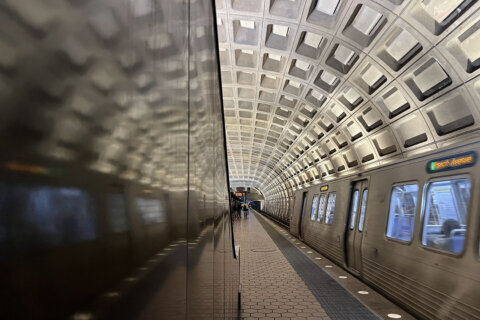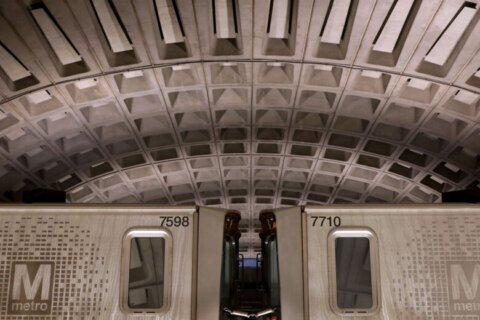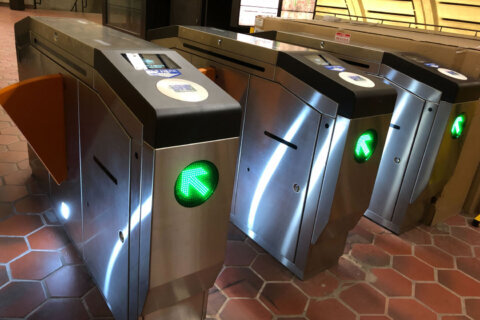WASHINGTON — After a derailment last month and a series of other safety issues tied to the tracks, the Federal Transit Administration said in a long-awaited report Monday that Metro fails to properly train track inspectors, does not give those inspectors enough time on the tracks and fails to fully utilize a high-tech automated inspection vehicle.
The report, which is mainly based on the FTA “safety blitz” investigation completed this spring, directs Metro to review track inspection resources and training, address conflicts and confusion in a key track maintenance and inspection manual, increase oversight of track quality, and improve track construction and maintenance.
Additional information was added after the July 29 derailment of a Silver Line train near East Falls Church, according to the report.
A visual inspection by FTA investigators confirmed crossties in poor condition, loose and missing fasteners, “and evidence of excessive lateral rail movement and wide gauge,” the directive said. “These conditions clearly exceeded allowable safety parameters specified in WMATA’s track safety standards, and were not found or addressed by WMATA personnel prior to the derailment.”
Inspectors also found evidence, alluded to by the National Transportation Safety Board, that Metro has not been adhering to its own standards for the frequency of track inspections.
The report from the FTA also notes that Metro was aware of the significant problems with the interlocking at East Falls Church where the train derailed, but scheduled the work for later in the new trackwork program in order to keep trains running on a single track between Ballston and East Falls Church during last month’s work zone.
Metro told the FTA and National Transportation Safety Board that it will now conduct in-depth inspections of any switches and crossovers that will get heavy use due to round-the-clock single tracking or closures. Metro also said it has begun an immediate special inspection of all tracks where trains carry passengers.
Automated track safety vehicle back on the tracks
Even before the latest derailment, FTA inspectors had been analyzing problems with Metro’s track inspection and maintenance program.
Tracks that were too far apart and that should have been taken out of service by track inspectors were also blamed for a derailment last year near Smithsonian.
The automated Track Geometry Vehicle that also spotted the irregularity in that area, but whose warning was deleted, has been out of service recently, Rep. Barbara Comstock, R-Va., confirmed in a statement Friday.
It was spotted back on the tracks over the weekend.
The vehicle, which Monday’s FTA report said is not being utilized enough to ensure tracks are safe across the Metro system, has sensors that can detect problems within rails as well as with the distance between them. It can also detect hot spots in tunnels where there could be potential electrical issues. When Metro got the vehicle in 2012, it said some testing could be done at speeds up to 60 mph.
FTA: Metro needs more time for track inspection
The FTA said in a statement last week that the initial indications following the latest derailment showed continuing “systemic safety deficiencies in the maintenance and repair” of tracks that were similar to what inspectors found during a “safety blitz” earlier this year.
In the latest safety directive, the FTA found track inspectors receive inadequate training, there is insufficient time for track inspections, and issues with crossties and wear in special track work zones is not being identified and addressed.
“WMATA must establish a new track inspection plan that expands time available for track inspection through additional inspection shifts (i.e., evening and nighttime) and more frequent inspections of priority locations,” one required action said.
Other required actions include developing additional training, certification and mentoring, and committing “adequate resources and technically qualified personnel to the inspection of special trackwork and the completion of required corrective maintenance.”
FTA uncovers problems with Metro’s drainage system, welding practices
The FTA also finds Metro fails to use its inspection data to prioritize repairs, which is compounded by a lack of understanding from maintenance crews of what inspectors are finding.
Additionally, the FTA said when new fasteners are installed, there is not the same quality control as there is for the new construction on the Silver Line. Problems with bolts and related issues can lead to unscheduled delays as Blue, Orange and Silver Line riders saw recently near Stadium-Armory — or cause more serious issues.
The anchor bolts on some fasteners holding the rails directly onto concrete have not all been installed correctly.
“Also, the [FTA] verified that much of the drainage system in WMATA’s tunnel structure is not maintained in a state of good repair,” the report stated. “Given the corrosive and deleterious effects of water on track and traction power infrastructure, [FTA] found that drain maintenance should be a much higher priority in WMATA’s overall track inspection and maintenance program.”
FTA inspectors also found that Metro has used “welding practices inconsistent with its construction standards to install cables to ensure train control and electrical continuity around mechanical joints”.
The FTA directed Metro to replace certain bonds that are used in the signaling system with bolted cables as specified by Metro’s own standards.
The agency has other issues with train operators speeding or running red signals, and the FTA finds that Metro does not have a clear process in place for track inspectors and supervisors to impose or remove speed restrictions.
“Since FTA assumed temporary safety oversight of Metrorail in October 2015, WMATA has taken of number of critical steps to address safety deficiencies, but significant additional work remains to be done,” the track integrity investigation final report said.
The safety blitz inspections focused on 10 segments covering more than 60 miles of tracks, and the report includes other inspections that have been done over the last several months.
During that time, the FTA oversight group told Metro it was concerned about overall track conditions between Vienna and Ballston, since many pieces are “reaching the end of their useful life.”
The track inspections also found missing fasteners or rail ties, corroded rails, a cracked third rail, broken third rail support brackets, standing water and blocked drains in the middle of the tracks, rail and other debris blocking emergency safety walks, lights out at emergency phone stations, exposed wires, and dark tunnels.
In three locations, FTA inspectors found gaps in fasteners on concrete beds more than 10 feet long, which Metro standards say should have immediately led to the track being taken out of service until the issue was addressed.
In two of those locations, Metro supervisors instead allowed trains to go through the area at up to 15 mph. In the third location, the track was removed from service, because the gap between fasteners was nearly 40 feet.
“This is almost four times the minimum allowed by WMATA’s maintenance standards,” the report said. “WMATA requires a twice weekly mainline walking inspections and monthly switch inspections. In the course of one month, this area would have been inspected, at a minimum, nine times, yet this condition was not identified or addressed.”
Metro responds: We’ll meet deadlines for improvements
As of March, the FTA said 21 Metro track inspectors had five or more years of experience, and nine had three years. Another 13 employees have two years; 11 have one year and five are trainees who are expected to help expand the track inspection staff as the next phase of the Silver Line opens.
Today, Metro typically has inspectors walk tracks largely only between 10 a.m. and 2 p.m., and spend about 30 minutes of that time clearing the tracks waiting for trains to pass.
“In essence this means that one inspector spends 3 1/5 hours inspecting 4 to 5 miles of track each day while under the constant distraction of passing trains and the need to clear,” the report said.
“The constraints placed on this inspection activity clearly limit its effectiveness,” the report continued
Metro has 30 days to respond to the directive.
In a statement, Metro spokesperson Sherri Ly said “Metro is working on a number of these corrective actions and will meet the FTA’s deadline for all recommendations.”







